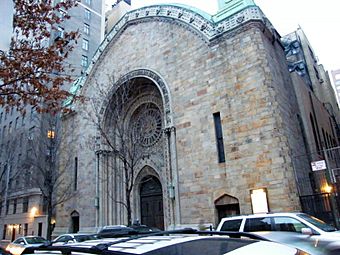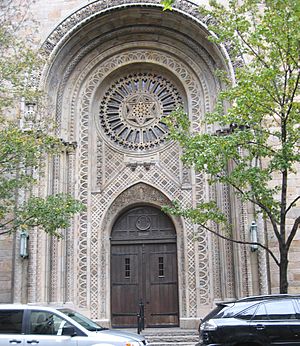B'nai Jeshurun (Manhattan) facts for kids
Quick facts for kids |
|
|
Congregation B'nai Jeshurun Synagogue and Community House
|
|

Congregation B'nai Jeshurun, March 2009
|
|
| Location | 257 W. 88th St. and 270 W. 89th St., New York, New York |
|---|---|
| Area | 0.9 acres (0.36 ha) |
| Built | 1917 |
| Architect | Schneider, Walter S.; Et al. |
| Architectural style | Late 19th And Early 20th Century American Movements, Semitic Revival |
| NRHP reference No. | 89000474 |
| Added to NRHP | June 2, 1989 |
B'nai Jeshurun is a synagogue located in the Upper West Side area of Manhattan, New York City. It is a special place for Jewish people to gather, pray, and learn.
Contents
History of B'nai Jeshurun
B'nai Jeshurun was founded in 1825. It was the second synagogue ever started in New York City. It is also the third-oldest Ashkenazi synagogue in the entire United States.
Early Beginnings and Moves
The synagogue was started by young people from another synagogue called Congregation Shearith Israel. They were joined by Jewish immigrants and their families from Germany and Poland. They wanted to follow the "German and Polish way" of Jewish prayer and customs, which is called minhag.
Their prayers followed the style of the Great Synagogue of London. They even asked the British chief Rabbi Solomon Hirschell for advice on religious rules. They first held services on Pearl Street. In 1829, they opened their first building on Elm Street in Manhattan.
The first rabbi, Samuel Myer Isaacs, started working there in 1839. By 1850, the congregation had grown very large. They needed a bigger building. A new synagogue on Greene Street was opened on September 25, 1851.
B'nai Jeshurun also had a cemetery on 32nd Street.
In 1864, the congregation moved again to a new building on 34th Street. This spot is now part of the famous Macy's store. Because the city was growing so fast, they moved one more time in 1885. This new building was on Madison Avenue at 65th Street. It was designed by Rafael Guastavino and Schwarzmann & Buchman.
Less than a year later, a fire badly damaged the building. The congregation had to temporarily move to another synagogue.
Henry Jacobs was another important rabbi who served for 17 years, ending in 1893.
The Current Building
The synagogue's current building is at 257 West 88th Street. It is located between Broadway and West End Avenue. This building was officially opened in 1917. It was designed by Henry B. Herts, who was a member of the synagogue and a famous theater architect.
This building is listed on the National Register of Historic Places. It is also part of the New York City Riverside Drive-West End Historic District. The special ceiling, which looks like a night sky, was rebuilt after it collapsed during renovations in the early 1990s.
New Synagogues Started by Members
Over the years, some members of B'nai Jeshurun left to start their own synagogues. This happened several times.
- In 1828, a group left to create Ansche Chesed.
- In 1845, about 50 members, mostly from England and the Netherlands, started Temple Shaaray Tefila.
Changes in Religious Approach
B'nai Jeshurun played a big role in forming the Board of Directors of American Israelites in 1859. By 1874, there were different ideas within the synagogue. Some wanted to stay strictly Orthodox, while others wanted to adopt ideas from the Reform movement.
In 1870, B'nai Jeshurun worked with other synagogues to create a common prayer book, called a siddur. In 1889, the congregation published its own version of the prayer book.
Later, B'nai Jeshurun joined the United Synagogue of America. This group was formed to support a more traditional, but still changing, form of Judaism. Today, this group is called the United Synagogue of Conservative Judaism.
In the 1990s, the congregation decided to become independent. This means they are not officially part of any larger Jewish movement anymore.
Recent Times
In 1985, Rabbi Marshall Meyer arrived, and the synagogue began to grow and become more active.
Since 1995, B'nai Jeshurun has hosted a special Seder meal called a "Stonewall Shabbat Seder."
Notable Clergy
Many important rabbis have served at B'nai Jeshurun:
- Rabbi Samuel Myer Isaacs (1839-1878)
- Rabbi Stephen Samuel Wise (1893-1906)
- Rabbi Judah Leon Magnes (1911-1912)
- Rabbi Israel Goldstein (1918-1960)
- Rabbi William Berkowitz (1950-1984)
- Rabbi Marshall Meyer (1985-1993)
- Rabbi Rolando Matalon (1986-present)
See also
 In Spanish: Sinagoga B'nai Jeshurun para niños
In Spanish: Sinagoga B'nai Jeshurun para niños





